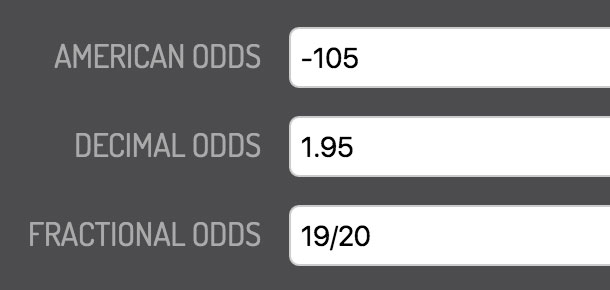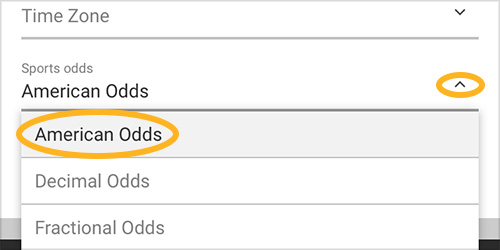Decimal Odds To American
It is vital to know how to convert different betting odds so that you can play with a variety of bookmakers worldwide. In the United States of America, American odds are used, across Europe, Decimal odds are used. Fractional odds are a more traditional method that is mostly used in horse racing.
The formula to convert European odds (decimals) to American moneyline format depends if the odds are 2.00+, or 1.999 or less. Odds $2.00+ To convert European decimal odds 2.00 or greater to an American moneyline the math is: 100. (Decimal odds -1). Decimal Odds – Decimal Odds, also referred to as European Odds, are used in most European countries and are the default option of many Asian bookies as well. This is the easiest odds format to understand as the odds represent how much a 1 unit wager returns. For example a €1 wager at odds.
Here is a step by step guide on how to convert the different odds types:
Decimal to Fractional conversion:
Let’s use a 1.75 decimal odd as an example:
- Remove 1 from the decimal odd and convert it to a fraction.
1.75 – 1 = 0.75 = 75/100 - Reduce the fraction to the simplest form.
75/100 = 3/4

3/4 is the Fraction odds equivalent of 1.75 Decimal odds.

Decimal to American conversion:
There are two methods, one for decimal odds more than 2.00 and one for decimal odds less than 2.00.
To convert a decimal odd of 2.00 or higher, let’s use 3.35 as an example:
- The moneyline equals the decimal odds minus 1 times 100.
(3.35 – 1) x 100 = +235
+235 is the American odds equivalent of 3.35 Decimal odds.
To convert a decimal odd of less than 2.00, let’s use 1.9091 as an example:
- The moneyline equals -100 divided by the decimal odds minus 1.
(-100) / (1.9091 – 1) = -109.99 = -110 - Then round the answer off into the closest round number.
109.99 = -110
-110 is the American odds equivalent of 1.9091 Decimal odds.
Fractional to American conversion:
Odds To Probability Converter
There are two methods, one for fractional odds more than 1/1 and one for fractional odds less than 1/1.
To convert a fractional odd of 1/1 or higher, let’s use 7/4 as an example:
- Convert the fraction to decimals by multiplying it by 100.
7/4 * 100 = 1.40 - Then multiply that number by 100 again.
1.40 * 100 = +140
+140 is the American odds equivalent of 7/4 Fractional odds.
To convert a fractional odd of 1/1 or lower, let’s use 1/10 as an example:
- Convert the fraction to decimals by multiplying it by 100.
1/10 * 100 = 0.1 - Divide -100 by that answer.
-100/0.1 = -1000
-1000 is the American odds equivalent of 1/10 Fractional odds.
Fractional to Decimal conversion:
Let’s use a 3/4 fractional odd as an example:
- Convert the fraction to a decimal by multiplying it by 100.
3/4 x 100 = 0.75 - Add 1 to the decimal answer.
0.75 + 1 = 1.75
1.75 is the Decimal odds equivalent of 3/4 Fractional odds.
American to Decimal conversion:
There are two methods, one for positive (+) odds and one for negative (-) odds.
To convert a positive odd, let’s use +235 as an example:
- Divide the money line by 100.
235/100 = 2.35 - Add 1 to the previous answer.
2.35 + 1 = 3.35

3.35 is the Decimal odds equivalent of +235 American odds.
To convert a negative odd, let’s use -110 as an example:
- Divide 100 by the money line.
100/110 = 0.9091 - Add 1 to the previous answer.
0.9091 + 1 =1.9091
1.9091 is the Decimal odds equivalent of -110 American odds.
Luckily, most online bookmakers have options to convert the odds automatically, but it is always a good idea to know the maths behind odd conversions in case that option isn’t available.

By convention only a set of fractions are used in fractional odds betting markets. The set does not include exact mathematical equivalents to all possible decimal and American odds. We use the closet fraction that is used in betting markets.
For example, the exact mathematical equivalent of decimal odds 30 is fractional odds 29/1. However 29/1 is not used in betting markets, instead 30/1 is used, so that is what appears in this converter.
For an explanation of the odds types on this table see decimal, fractional and American odds. To find out what the numbers really represent see understand odds as probability with overround.